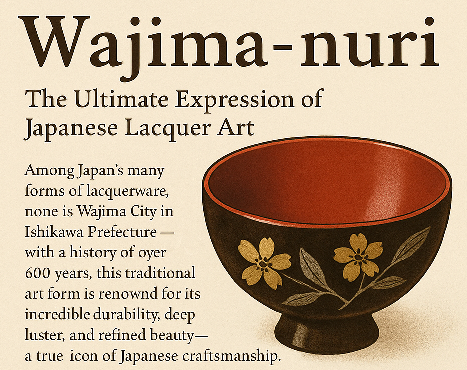
Among Japan’s many forms of lacquerware, none is more admired or celebrated than Wajima-nuri, the exquisite craft of Wajima City in Ishikawa Prefecture. With a history of over 600 years, this traditional art form is renowned for its incredible durability, deep luster, and refined beauty—a true icon of Japanese craftsmanship.
While lacquerware itself is not unique to Japan, the techniques used in Wajima-nuri are unlike any other. Each piece is made through a labor-intensive process involving more than 100 individual steps. Craftsmen first reinforce the wooden base with cloth and a special clay-lacquer mixture called jinoko, creating a body that is remarkably strong. Then, layer upon layer of natural lacquer is applied and polished to a smooth, glowing finish.
One of the most striking features of Wajima-nuri is its timeless design. Bold yet elegant, these pieces often feature gold and silver maki-e (sprinkled metal powder) or delicate chinkin (carved gold inlay) decorations, each crWhen people think of Japanese lacquerware, few names shine brighter than Wajima-nuri, the exquisite traditional craft from Wajima City in Ishikawa Prefecture. With over a thousand years of history, Wajima-nuri represents the pinnacle of artistry, durability, and cultural depth in Japanese crafts.
What sets Wajima-nuri apart is its remarkable strength and elegance. Unlike many other lacquerwares, it uses a base of multiple layers of urushi lacquer mixed with powdered diatomaceous earth (jinoko), giving it a sturdy foundation capable of lasting generations. The process involves more than 100 intricate steps, all executed by highly skilled artisans who often specialize in just one stage of production. The final result is a glossy, deep black or red surface, sometimes adorned with makie (gold or silver powder decoration), showcasing both timeless beauty and masterful technique.
For many foreign visitors, Wajima-nuri is more than just tableware—it’s a symbol of Japan’s devotion to harmony, patience, and respect for nature. Each piece reflects the values embedded in Japanese aesthetics: simplicity, subtlety, and craftsmanship born of tradition.
In recent years, Wajima-nuri has also found a place in modern living. Designers are creating contemporary forms that blend seamlessly with Western interiors, and more people overseas are discovering its charm as both an art object and a functional piece for daily use. Whether you’re sipping green tea or displaying it on a shelf, Wajima lacquerware brings a sense of calm elegance to any moment.
However, Wajima and its people have faced immense challenges. In January 2024, a devastating earthquake struck the Noto Peninsula, affecting many areas in Ishikawa Prefecture, including Wajima City. Workshops were damaged, and artisans lost precious tools and materials. Yet, even amid hardship, the spirit of Wajima lives on. Artisans are rebuilding, supported by local and international communities who believe in the value of this heritage. Buying or learning about Wajima-nuri today is also an act of support for the ongoing recovery and preservation of tradition.
As you explore Japan or dive deeper into its culture from afar, consider Wajima-nuri not just as an object, but as a living story—one that continues to evolve, endure, and inspire.afted by master artisans. The result? A piece that is not just functional, but a living work of art.
Even today, Wajima-nuri is considered a luxury item, often used in tea ceremonies, high-end restaurants, and gifted to dignitaries. It represents more than just a dish or a tray—it is a testament to patience, precision, and the spirit of Japanese tradition.
If you’re searching for a souvenir that embodies the soul of Japanese elegance and artistry, look no further. Wajima-nuri offers a piece of Japan that is both beautiful and enduring—something to be treasured for generations.
輪島塗:石川県からの日本漆器の魂
人々が日本の漆器について考えるとき、石川県輪島市からのこの精緻な伝統工芸、輪島塗ほど輝く名前はほとんどありません。千年以上の歴史を持つ輪島塗は、日本の工芸における芸術性、耐久性、文化的深みの頂点を表しています。
輪島塗を特別なものにしているのは、その驚くべき強さと優美さです。他の多くの漆器とは異なり、それは珪藻土(地の粉)を混ぜた漆を重ねることで、世代を超えて使える頑丈な基礎を作り出します。この工程は、100以上の精緻な工程を含み、それぞれの工程は、しばしば一つの段階のみに専門化した高度な技術を持つ職人によって行われます。最終的に仕上がるのは、深みのある黒や赤の光沢を持つ表面で、時には**蒔絵(金や銀の粉による装飾)**が施されており、時を超えた美しさと熟練技術を示しています。
多くの外国人旅行者にとって、輪島塗は単なる器ではなく、日本の調和、忍耐、自然への敬意に対する献身の象徴です。それぞれの作品は、日本の美意識に埋め込まれた価値観――簡素さ、控えめさ、そして伝統から生まれる職人技――を映し出しています。
近年、輪島塗は現代の暮らしの中でも居場所を見つけています。デザイナーたちは現代的な形を作り出し、西洋のインテリアにも自然に溶け込むようになりました。海外ではより多くの人々が、それを芸術作品であり日常で使える道具としての魅力を発見しています。抹茶をすする時でも、棚に飾る時でも、輪島塗はどんな瞬間にも穏やかな優雅さをもたらします。
しかし、輪島とその人々は大きな試練に直面しました。2024年1月、能登半島を壊滅的な地震が襲い、石川県の多くの地域、特に輪島市に影響を与えました。工房は損壊し、職人たちは貴重な道具や素材を失いました。それでも困難の中にあっても、輪島の精神は生き続けています。職人たちは再建に取り組んでおり、この遺産の価値を信じる国内外のコミュニティによって支えられています。今日、輪島塗を購入したり学んだりすることは、復興と伝統の継承への支援の行為でもあります。
日本を訪れる際や遠くから日本文化を深く探求する際には、輪島塗を単なる物としてではなく、生きている物語として捉えてください――それは今も進化し、耐え抜き、人々を魅了し続けているのです。
